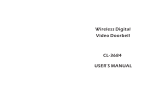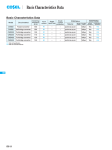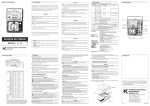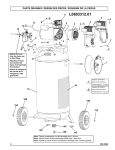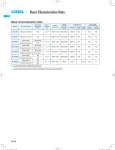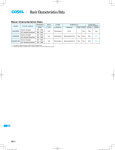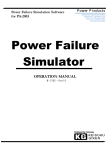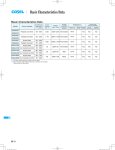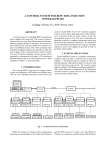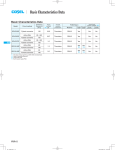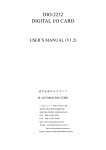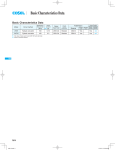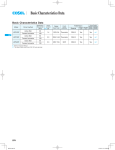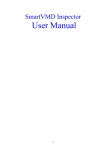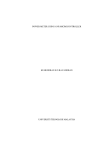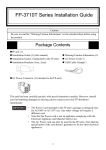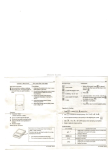Download Basic characteristics data • Instruction manual
Transcript
Basic Characteristics Data Basic Characteristics Data Model LFP LFP100F LFP150F LFP240F LFP300F Circuit method Switching frequency [kHz] Active filter 60 Forward converter 130 Active filter 60 Forward converter 130 Active filter 60 Forward converter 130 Active filter 60 Forward converter 140 *1 The value of input current is at ACIN 100V and rated load. *2 Refer to Instruction Manual 2. LFP-10 Inrush current protection Material 1.3 Thermistor 2.0 Input current *1 [A] Series/Parallel operation availability PCB/Pattern Single sided *2 Double sided Series operation Parallel operation CEM-3 Yes Yes No Thermistor CEM-3 Yes Yes No 3.6 SCR CEM-3 Yes Yes No 4.3 SCR CEM-3 Yes Yes No AC-DC Power Supplies Open Frame/ Enclosed Type Instruction Manual 1 2 3 Function LFP-12 1.1 Input voltage range LFP-12 1.2 Inrush current limiting LFP-12 1.3 Overcurrent protection LFP-12 1.4 Overvoltage protection LFP-12 1.5 Thermal protection LFP-12 1.6 Output voltage adjustment range LFP-12 1.7 Output ripple and ripple noise LFP-12 1.8 Isolation LFP-13 1.9 Reducing standby power LFP-13 Series Operation and Parallel Operation LFP-13 2.1 Series Operation LFP-13 2.2 Parallel Operation LFP-13 Assembling and Installation Method LFP-13 3.1 Installation method LFP-13 3.2 Derating LFP-13 3.3 Mounting screw LFP-15 3.4 Expectancy life and warranty LFP-16 4 Ground LFP-16 5 Peak loading LFP-17 6 Option and Others LFP-17 6.1 Outline of options LFP-17 6.2 Others LFP-19 LFP-11 LFP AC-DC Power Supplies Open Frame/ Enclosed Type 1.4 Overvoltage protection 1 Function LFP Instruction Manual ¡An overvoltage protection circuit is built-in. If the overvoltage protection circuit is activated, shut down the input voltage, wait more than 3 minutes and turn on the AC input again to recover the out- 1.1 Input voltage range put voltage. Recovery time varies depending on such factors as ¡The range is from AC85V to AC264V or DC120V to DC370V (please see SPECIFICATIONS for details). ¡In cases that conform with safety standard, input voltage range is AC100-AC240V (50/60Hz). input voltage value at the time of the operation. ¡In option -R2, overvoltage protection is removed by toggling ON/ OFF signal of remote control. Remarks : ¡If input value doesn’t fall within above range, a unit may not operate in accordance with specifications and/or start hunting or fail. Please avoid applying a voltage exceeding the rated voltage to an If you need to apply a square waveform input voltage, which is tion or fail. If you cannot avoid doing so, for example, if you need commonly used in UPS and inverters, please contact us. to operate a motor, etc., please install an external diode on the ¡When the input voltage changes suddenly, the output voltage accuracy might exceed the specification. Please contact us. ¡Operation stop voltage is set at a lower value than that of a standard version (derating is needed). -Use Conditions Output LFP100F LFP150F LFP240F LFP300F 30W 50W 80W 100W *Please avoid using continuously for more than 1 second under above conditions. Doing so may cause a failure. Input AC50V or DC70V Duty 1s/30s 1.2 Inrush current limiting ¡An inrush current limiting circuit is built-in. ¡If you need to use a switch on the input side, please select one that can withstand an input inrush current. ¿ LFP100F, LFP150F ¡Thermistor is used in the inrush current limiting circuit. When you turn the power ON/OFF repeatedly within a short period of time, output terminal. Doing so may cause a power supply to malfunc- output terminal to protect the unit. 1.5 Thermal protection ¡A thermal protection circuit is built-in. The thermal protection circuit may be activated under the following conditions and shut down the output. 1When a temperature continue to exceed the values determined by the derating curve. 2When a current exceeding the rated current is applied. 3When convection stops. 4When peak load is applied in conditions other than those shown in Section 5. If the thermal protection circuit is activated, shut off the input voltage and eliminate all the overheating conditions. To recover the output voltage, have enough time to cool down the unit before turning on the input voltage again. 1.6 Output voltage adjustment range ¡Adjustment of output voltage is possible by using potentiometer. please have enough intervals so that a power supply cools down before being turned on. ¿ LFP240F, LFP300F ¡Thyristor technique is used in the inrush current limiting circuit. When you turn power ON/OFF repeatedly within a short period of 1.7 Output ripple and ripple noise ¡Output ripple noise may be influenced by measurement environment, measuring method fig.1.1 is recommended. +Vout time, please have enough intervals so that the inrush current limit- C1 C2 + ing circuit becomes operative. ¡When the switch of the input is turned on, the primary inrush current and secondary inrush current will be generated because the -Vout 150mm Osiloscope/ Ripple noise meter Bw:20MHz thyristor technique is used for the inrush current limiting circuit. 1.3 Overcurrent protection ¡An overcurrent protection circuit is built-in and activated at 101% of the peak current. A unit automatically recovers when a fault Load Differential probe C1 : Film capacitor 0.1μF C2 : Aluminum electrolytic capacitor 22μF condition is removed. Please do not use a unit in short circuit and/or under an overcurrent condition. ¡Intermittent Operation Mode Intermittent operation for overcurrent protection is included in a Fig.1.1 Measuring method of Ripple and Ripple Noise Remarks : When GND cable of probe with flux of magnetic force from power supply are crossing, ripple and ripple noise might not measure part of series. When the overcurrent protection circuit is activated correctly. and the output voltage drops to a certain extent, the output be- Please note the measuring environment. comes intermittent so that the average current will also decrease. LFP-12 AC-DC Power Supplies Open Frame/ Enclosed Type Instruction Manual ¡Even a slight difference in output voltage can affect the balance between the values of I1 and I2. Please make sure that the value of I3 does not exceed the rated current of a power supply. I3 [ the rated current value LFP Bad example Good example Fig.1.2. Example of measuring output ripple and ripple noise 3 Assembling and Installation Method 1.8 Isolation ¡For a receiving inspection, such as Hi-Pot test, gradually increase (decrease) the voltage for the start (shut down). Avoid using HiPot tester with the timer because it may generate voltage a few times higher than the applied voltage, at ON/OFF of a timer. 3.1 Installation method ¡This power supply is manufactured by SMD technology. The stress to P.C.B like twisting or bending causes the defect of the unit,so handle the unit with care. ¡In case of metal chassis, keep the distance between d1 & d2 for to insulate between lead of component and metal chassis, use the 1.9 Reducing standby power ¡As for option -R2, reducing standby power is possible by OFF signal of the remote control. spacer of 8mm or more between d1. If it is less than d1 & d2, insert the insulation sheet between power supply and metal chassis. Please refer to instruction manual 6.1. d2 CN1 2 Series Operation and Parallel Operation d1 = 8mm min d2 CN1 d2 d2 2.1 Series Operation d2 = 4mm min ¡You can use a power supply in series operation. The output current in series operation should be lower than the rated current of a d2 power supply with the lowest rated surrent among power supplies Fig.3.1 Installation method that are serially connected. Please make sure that no surrent ex- ¡There is a possibility that it is not possible to cool enough when the power supply is used by the sealing up space as showing in Load Power + Supply - Power + Supply - Load Power + Supply - Power + Supply - Figure 3.2. Load ceeding the rated current flows into a power supply. B of Instruction Manual 3.2. Please use it after confirming the temperature of point A and point Case Fig.2.1 Examples of connecting in series operation Power supply 2.2 Parallel Operation Fig.3.2 Installation example ¡Parallel operation is not possible. ¡Redundancy operation is available by wiring as shown below. + I1 I3 Power Supply - ¡Environment to use it and Installation environment When using it,it is necessary to radiate heat by the heat of the power supply. Load Power + Supply - 3.2 Derating I2 Table 3.1 - 3.4 shows the relation between the upper limit temperature (Point A and Point B) and load factors. Please consider the ventilation so that the convection which is enough for the whole power supply is provided. And temperature of Point A and Point B please become lower than Fig.2.2 Example of redundancy operation upper limit temperature. LFP-13 AC-DC Power Supplies Open Frame/ Enclosed Type The expectancy life in the upper bound temperature (Point A and Point B) is three years or more. Please refer to External View for the position of Point A and Point B. In case of with Chassis and Cover, please contact our sales office potential. *Please refer to 3.4 if you want to extend the longevity of the expectancy life. Table 3.1 Temperatures of Point A, Point B LFP100F-O-Y Cooling Method Load factor 75%<Io[100% Convection 50%<Io[75% 0%<Io[50% 75%<Io[100% Convection 50%<Io[75% B 0%<Io[50% 75%<Io[100% Convection 50%<Io[75% C 0%<Io[50% 75%<Io[100% Convection 50%<Io[75% D 0%<Io[50% 75%<Io[100% Convection 50%<Io[75% E 0%<Io[50% 75%<Io[100% Convection 50%<Io[75% F 0%<Io[50% 70%<Io[100% A,B,C,D,E,F Forced air 0%<Io[70% A Max temperature Point A[C] Point B[C] 88 86 89 89 89 89 82 81 89 89 89 89 85 86 89 89 89 89 84 76 89 86 89 89 81 89 86 89 87 89 80 77 85 86 88 89 75 75 75 75 Table 3.2 Temperatures of Point A, Point B LFP150F-O-Y Mounting Cooling Method Method Load factor 75%<Io[100% Convection 50%<Io[75% 0%<Io[50% 75%<Io[100% Convection 50%<Io[75% B 0%<Io[50% 75%<Io[100% Convection 50%<Io[75% C 0%<Io[50% 75%<Io[100% Convection 50%<Io[75% D 0%<Io[50% 75%<Io[100% Convection 50%<Io[75% E 0%<Io[50% 75%<Io[100% Convection 50%<Io[75% F 0%<Io[50% 70%<Io[100% A,B,C,D,E,F Forced air 0%<Io[70% A Mounting Cooling Method Method Load factor 75%<Io[100% Convection 50%<Io[75% 0%<Io[50% 75%<Io[100% Convection 50%<Io[75% B 0%<Io[50% 75%<Io[100% C Convection 50%<Io[75% 0%<Io[50% 75%<Io[100% D Convection 50%<Io[75% 0%<Io[50% 75%<Io[100% E Convection 50%<Io[75% 0%<Io[50% 75%<Io[100% Convection 50%<Io[75% F 0%<Io[50% 70%<Io[100% A,B,C,D,E,F Forced air 0%<Io[70% Max temperature Point A[C] Point B[C] 84 81 89 89 89 89 83 81 89 89 89 89 87 85 89 89 89 89 83 65 89 75 89 85 77 86 81 89 86 89 78 76 82 82 89 89 75 75 75 75 Max temperature Point A[C] Point B[C] Point C[C] 89 82 89 88 89 89 85 74 89 82 89 89 89 83 89 88 89 89 88 74 89 85 89 89 89 86 89 89 89 89 79 68 86 77 89 89 75 75 85 75 75 85 Table 3.4 Temperatures of Point A, Point B, Point C, Point D LFP300F-O-TY Mounting Cooling Method Method Load factor 80%<Io[100% Convection 60%<Io[80% Io[60% 80%<Io[100% B Convection 60%<Io[80% Io[60% 80%<Io[100% Convection 60%<Io[80% C Io[60% 80%<Io[100% Convection 60%<Io[80% D Io[60% 80%<Io[100% Convection 60%<Io[80% E Io[60% 50%<Io[100% A,B,C,D and E Forced air Io[50% A Max temperature Point A[C] Point B[C] Point C[C] Point D[C] 70 86 75 88 79 89 59 68 68 76 76 86 70 84 77 89 80 89 57 64 65 73 77 83 60 79 66 81 76 88 75 75 85 85 75 75 85 85 ¡The operative ambient temperature is different by with / without chassis cover or mounting position. Derating curve is shown below. Note: In the hatched area, the specification of Ripple, Ripple Noise is different from other area. ¿ LFP100F 1(A)mounting 1 (D), (E), (F) 1(C)mounting 1(B)mounting mounting 2 (A) ~ (F) mounting 100 Load factor [%] Remarks: *Please be careful of electric shock or earth leakage in case of temperature measurement, because Point A and Point B is live Mounting Method Table 3.3 Temperatures of Point A, Point B, Point C LFP240F-O-Y A for getting more information. LFP Instruction Manual 80 70 60 50 40 30 20 0 -10 1Convection 2Forced air (0.5m3 / min) 0 10 20 30 35 40 45 50 60 70 Ambient temperature [C] Fig.3.3 Ambient temperature derating curve (refer to Table 3.1) LFP-14 Instruction Manual AC-DC Power Supplies Open Frame/ Enclosed Type ¿ LFP150F ¡Mounting method 1(D), (E), (F) mounting 1(C)mounting 1(B)mounting 1(A)mounting Load factor [%] 80 70 60 50 40 30 20 0 -10 (A) 2 (A) ~ (F) mounting 100 (B) CN1 (C) CN1 1Convection 2Forced air (0.5m3 / min) 0 10 20 LFP 30 40 45 50 60 CN1 Standard Position 70 Ambient temperature [C] (D) Fig.3.4 Ambient temperature derating curve (refer to Table 3.2) (E) (F) CN1 ¿ LFP240F 1 (D), (E)mounting 1 (C)mounting 1 (B)mounting 1 (A)mounting 1 (F)mounting 2 (A) ~ (F) mounting Load factor [%] 100 80 70 60 1Convection 2Forced air (0.5m3 / min) 40 30 20 0 -10 CN1 CN1 Fig.3.8 Mounting method 0 10 20 25 30 35 40 45 50 60 70 ¡(F) of LFP300F is not possible. (F) mounting is not possible when unit is with case cover, but if need to operate unit by (F) position- Ambient temperature [C] Output power[W] 1Convection 2Forced air 240.0 300.0 240.0 300.0 241.2 302.4 240.0 302.4 Output voltage 24V 30V 36V 48V ing with case cover, temperature / load derating is necessary. For more details, please contact our sales or engineering departments. 3.3 Mounting screw Fig.3.5 Ambient temperature derating curve (refer to Table 3.3) ¿ LFP300F 1 (D), (E)mounting 1 (B), (C)mounting 1 (A)mounting 2 (A) ~ (E) mounting Load factor [%] 100 80 1Convection 2Forced air (0.5m3 / min) 60 50 40 20 10 0 -10 0 10 20 24V 30V 36V 48V ¡If metallic fittings are used on the component side of the board, ensure there is no contact with surface mounted components. ¡This product uses SMD technology. Please avoid the PCB installation method which includes the twisting stress or the bending stress. 25 30 40 50 60 70 Ambient temperature [C] Output voltage ¡The mounting screw should be M3. The hatched area shows the allowance of metal parts for mounting. Output power[W] 1Convection 2Forced air 300.0 360.0 300.0 360.0 302.4 360.0 302.4 360.0 *Recommendation to electrically connect FG to metal chassis for reducing noise. ¿ LFP100F, LFP150F 8 8 8 8 CN1 8 8 Fig.3.6 Ambient temperature derating curve (refer to Table 3.4) 8 ¡Derating curve depending on input voltage Derating curve depending on input voltage is shown in Fig.3.7. Fig.3.9 Allowance of metal for mounting ¿ LFP240F, LFP300F [%] Load factor Unit [mm] 8 8 8 100 8 8 CN1, TB1 80 [AC V] 8 85 90 Fig.3.7 Derating curve depending on input voltage 8 8 8 8 8 Unit [mm] Fig.3.10 Allowance of metal for mounting LFP-15 AC-DC Power Supplies Open Frame/ Enclosed Type Instruction Manual 3.4 Expectancy life and warranty ¡Warranty Table 3.9 Warranty (LFP100F-O-Y) ¡Expectancy Life. Table 3.5 Expectancy Life (LFP100F-O-Y) LFP Mounting Method Cooling Method A Convection B Convection C Convection D, E, F Convection A,B,C,D,E,F Forced air Average ambient temperature (year) Ta = 40C or less Ta = 50C Ta = 35C or less Ta = 45C Ta = 35C or less Ta = 45C Ta = 25C or less Ta = 35C Ta = 60C Expectancy Life Io[75% 75%<Io[100% 6years 6years 6years 5years 6years 6years 6years 5years 5years 5years 5years 3years 5years 5years 5years 3years 5years 3years Cooling Method A Convection B Convection C Convection D, E, F Convection A,B,C,D,E,F Forced air Average ambient temperature (year) Ta = 40C or less Ta = 50C Ta = 35C or less Ta = 45C Ta = 35C or less Ta = 45C Ta = 20C or less Ta = 30C Ta = 60C Expectancy Life Io[75% 75%<Io[100% 6years 6years 6years 5years 6years 6years 6years 5years 5years 5years 5years 3years 5years 5years 5years 3years 5years 3years Cooling Method A Convection B Convection C Convection D, E Convection F Convection A,B,C,D,E,F Forced air Average ambient temperature (year) Ta = 40C or less Ta = 50C Ta = 35C or less Ta = 45C Ta = 25C or less Ta = 35C Ta = 20C or less Ta = 30C Ta = 25C or less Ta = 60C Expectancy Life Io[75% 75%<Io[100% 6years 6years 6years 5years 6years 6years 6years 5years 5years 5years 5years 3years 5years 5years 5years 3years 5years 3years 5years 3years Table 3.8 Expectancy Life (LFP300F-O-TY) Mounting Method A B, C D, E A,B,C,D,E Cooling Method Average ambient temperature (year) Ta = 30C or less Convection Ta = 40C Ta = 20C or less Convection Ta = 30C Convection Ta = 25C or less Forced air Ta = 50C A Convection B Convection C Convection D, E, F Convection A,B,C,D,E,F Forced air Average ambient temperature (year) Ta = 40C or less Ta = 50C Ta = 35C or less Ta = 45C Ta = 35C or less Ta = 45C Ta = 25C or less Ta = 35C Ta = 60C Warranty Io[75% 75%<Io[100% 5years 5years 5years 3years 5years 5years 5years 3years 5years 5years 5years 3years 5years 5years 5years 3years 5years 3years Mounting Method Cooling Method A Convection B Convection C Convection D, E, F Convection A,B,C,D,E,F Forced air Average ambient temperature (year) Ta = 40C or less Ta = 50C Ta = 35C or less Ta = 45C Ta = 35C or less Ta = 45C Ta = 20C or less Ta = 30C Ta = 60C Warranty Io[75% 75%<Io[100% 5years 5years 5years 3years 5years 5years 5years 3years 5years 5years 5years 3years 5years 5years 5years 3years 5years 3years Table 3.11 Warranty (LFP240F-O-Y) Table 3.7 Expectancy Life (LFP240F-O-Y) Mounting Method Cooling Method Table 3.10 Warranty (LFP150F-O-Y) Table 3.6 Expectancy Life (LFP150F-O-Y) Mounting Method Mounting Method Expectancy Life Io[75% 75%<Io[100% 6years 6years 5years 3years 6years 6years 5years 3years 6years 5years 5years 3years Mounting Method Cooling Method A Convection B Convection C Convection D, E Convection F Convection A,B,C,D,E,F Forced air Average ambient temperature (year) Ta = 40C or less Ta = 50C Ta = 35C or less Ta = 45C Ta = 25C or less Ta = 35C Ta = 20C or less Ta = 30C Ta = 25C or less Ta = 60C Warranty Io[75% 75%<Io[100% 5years 5years 5years 3years 5years 5years 5years 3years 5years 5years 5years 3years 5years 5years 5years 3years 5years 3years 5years 3years Table 3.12 Warranty (LFP300F-O-TY) Mounting Method A B, C D, E A,B,C,D,E Cooling Method Average ambient temperature (year) Ta = 30C or less Convection Ta = 40C Ta = 20C or less Convection Ta = 30C Convection Ta = 25C or less Forced air Ta = 50C Warranty Io[75% 75%<Io[100% 5years 5years 5years 3years 5years 5years 5years 3years 5years 3years 5years 3years 4 Ground ¡When installing the power supply with your unit, ensure that the input FG terminal of CN1 or mounting hole FG is connected to safety ground of the unit. LFP-16 AC-DC Power Supplies Open Frame/ Enclosed Type Instruction Manual 1 AC100V 5 Peak loading 2 AC200V Duty [%] 40 ¡Peak load is possible to draw as below. LFP Output current [A] 10 lP : peak current 0 300 360 510 540 600 Peak Wattage[W] l ave : average current LFP300F lO Fig.5.1 Derating of peak loading 0 t1 [ 10 [sec], lave = t1 t [sec] t2 6 Option and Others IP t1+IO t2 [ rated current, t1+t2 t1 t1+t2 [ 0.40 (Refer to below chart) 6.1 Outline of option Duty is depended on peak load, refer to below chart. 1 AC100V 2 AC200V Duty [%] 40 -Option -C units have coated internal PCB for better moisture resistance. ¿ -G 20 10 0 100 ¿ -C -Option -G units are low leakage current type. -Differences from standard versions are summarized in Table 6.1. 160 200 Peak Wattage[W] Table 6.1 Low leakage current type LFP100F 1 AC100V 2 AC200V Duty [%] 40 Output Ripple Noise 0 150 N/A Please contact us for details about Ripple Noise Measured by 20MHz oscilloscope or Ripple-Noize meter (Equivalent to KEISOKU-GIKEN:RM-103). 240 300 ¿ -J (LFP300F) Peak Wattage[W] LFP150F -Option -J units, the input and output connector are changed to EP connectors (Mfr. Tyco Electronics). 1 AC100V 40 2 AC200V 3 Forced air -The appearance in option -J units is defferent from the standard untis. Please contact us about the detail. ¿ -J1 20 15 10 0 240 0.15mA max * This is the value that measured on measuring board with capacitor of 22μF at 150mm from output connector. 20 10 Duty [%] Leakage Current (AC240V 60Hz) Conducted Noise -Option -J1 units, the Input and Output connector is VH connectors (Mfr. J.S.T.). 360 Peak Wattage[W] LFP240F 480 -LFP300F appearance of option -J1 units is defferent from the standard appearance. Please contact us about the detail. ¿ -S--SN --S indicates a type with chassis, and -SN indicates a type with chassis and cover (Refer to external view). Please contact us about the detail of derating curve. -Please contact us about the detail of LFP300F. LFP-17 AC-DC Power Supplies Open Frame/ Enclosed Type ¿ -SNF (LFP300F-24-TY) ¿ -T (LFP240F, LFP300F) -In option -SNF, the cover, chassis and cooling fan are added. -The appearance of option -J and -J1 units is defferent from the of standard appearance. Please contact us about the detail. -Option -T units have vertically positioned screws on a terminal block. -Please contact us for details about appearance. -Oil and other chemical liquid splashing environment may cause the performance degradation and failure. FG -V AC (N) ¿ -R AC (L) +V -You can control output ON/OFF remotely in Option -R units. To do so, connect an external DC power supply and apply a voltFig.6.2 Example of option -T age to a remote ON/OFF connector, which is available as option. LFP100F, LFP150F LFP240F, LFP300F + screwdriver screw 780 R*1 External Power Source ¡The screw can be held to terminal block by inserting and lifting the screwdriver from the side of terminal block. 4.5 - 12.5 SW 0 - 0.5 RC (+) 1 RC (-) 2 20max Inside of a Power Supply Ri terminal block f5.5MAX Model Name Built-in Voltage between RC (+) Input and RC (-) [V] Resistor Current Ri [ W ] Output ON Output OFF [mA] Input Current Remote ON/OFF connector (Optional) Fig.6.1 Example of using a remote ON/OFF circuit -Dedicated harnesses are available for your purchase. Please see Optional Parts for details. *1 If the output of an external power supply is within the range of 4.5 - 12.5V, you do not need a current limiting resistor R. If Fig.6.3 lifting method ¿ -T1 (LFP300F) -Option -T1 units have horizontally positioned screws on a terminal block. -Please contact us for details about appearance. -V FG AC (N) the output exceeds 12.5V, however, please connect the current limiting resistor R. +V AC (L) To calculate a current limiting resistance value, please use the following equation. R[W]= Vcc-(1.1+RiX0.005) *Please wire carefully. If you wire wrongly, the internal components of a unit may be damaged. ¡Remote ON/OFF circuits (RC+ and RC-) are isolated from input, output and FG. ¿ -R2 -The usege is the same as option -R, please refer to Option -R. -Reducing standby power is possible by OFF signal of the remote control. -Start up time by ON signal in remote control is 350ms(typ). -The latch condition in overvoltage protection is removed by toggling ON/OFF signal of remote control. -Standby power LFP100F, LFP150F, LFP240F 0.2Wtyp (AC100V), 0.7Wtyp (AC200V) LFP300F 0.25Wtyp (AC100V), 1.1Wtyp (AC200V) LFP-18 Fig.6.4 Example of option -T1 0.005 ¿ -U1 (LFP240F, LFP300F) ¡By connecting the external capacitor unit CR-HUT(optional parts), Hold-up time is extensible. 10,000 Hold-up time [ms] LFP Instruction Manual External capacotor unit model 1,000 CR-HUT502-2 CR-HUT282-2 CR-HUT721-1 100 CR-HUT241-1 10 0 50 100 150 200 250 300 Output power [W] Fig.6.5 Hold-up time by LFP240F-O-U1Y(Reference data). AC-DC Power Supplies Open Frame/ Enclosed Type Instruction Manual Hold-up time [ms] 10,000 External capacotor unit model 1,000 CR-HUT502-2 CR-HUT282-2 CR-HUT721-1 CR-HUT241-1 100 LFP 10 0 50 100 150 200 250 300 350 Output power [W] Fig.6.6 Hold-up time by LFP300F-O-TU1Y(Reference data). ¡Connection method Power supply VC(+) VC(-) Harness H-IN-23 (sell separately) d=5 - 30mm CN1 VC(+) VC(-) External capacitor unit (CR-HUT) Fig.6.7 Connection method ¿Caution (1) Distance between the external capacitor unit and power supply unit must be secured more than 5mm. (2) It must be 30mm or less, since the noise is generated from the wire which is connecting the external capacitor unit and power supply. And, it is necessary to twist the wire as short as possible. (3) It is necessary to use wires which rated voltage is 600V or more. (4) It must be used with the external capacitor unit (CR-HUT). (5) For more information about the external capacitor unit and harness, please refer to the page to optional parts. 6.2 Others ¡This power supply is the rugged PCB type. Do not drop conductive objects in the power supply. ¡At light load, there remains high voltage inside the power supply for a few minutes after power OFF. So, at maintenance, take care about electric shock. ¡This power supply is manufactured by SMD technology. The stress to PCB like twisting or bending causes the defect of the unit, so handle the unit with care. -Tighten all the screws in the screw hole. -Install it so that PCB may become parallel to the clamp face. -Avoid the impact such as drops. ¡While turning on the electricity, and for a while after turning off, please don’t touch the inside of a power supply because there are some hot parts in that. ¡When a mass capacitor is connected with the output terminal (load side), the output might become the stop or an unstable operation. Please contact us for details when you connect the capacitor. LFP-19











